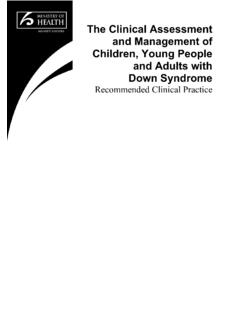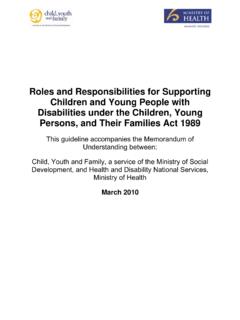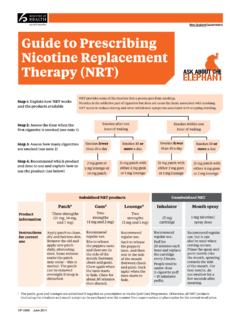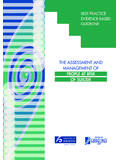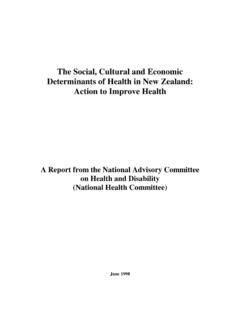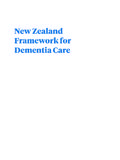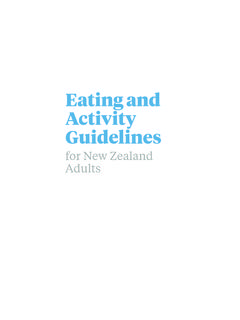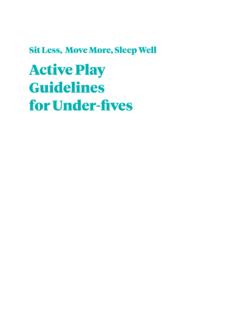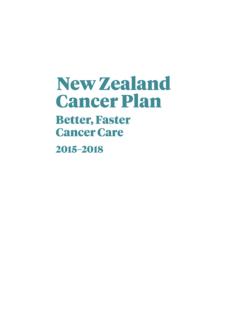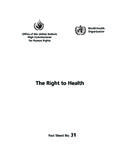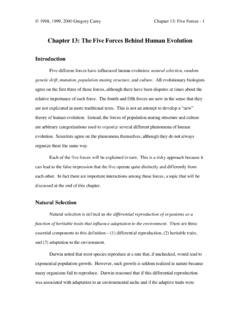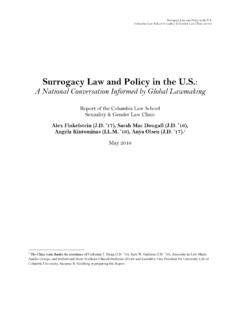Transcription of Family Violence Assessment and Intervention Guideline
1 Released 2016 Family Violence Assessment and Intervention Guideline Child abuse and intimate partner Violence The cover illustration is by Isabella Tupp, aged 7 years. Citation: Fanslow J L, Kelly P, Ministry of Health. 2016. Family Violence Assessment and Intervention Guideline : Child abuse and intimate partner Violence (2nd edn). Wellington: Ministry of Health. First published in 2002, second edition June 2016 by the Ministry of Health PO Box 5013, Wellington 6145, New Zealand ISBN: 978-0-947491-80-2 (print) ISBN 978-0-947491-81-9 (online) HP 6376 This document is available at This work is licensed under the Creative Commons Attribution International licence.
2 In essence, you are free to: share ie, copy and redistribute the material in any medium or format; adapt ie, remix, transform and build upon the material. You must give appropriate credit, provide a link to the licence and indicate if changes were made. Family Violence Assessment and Intervention Guideline : iii Child abuse and intimate partner Violence Foreword The Ministry of Health is pleased to publish this refreshed version of the Family Violence Assessment and Intervention Guideline : Child abuse and intimate partner Violence . It contains updated research and practice information to inform health care response to this important issue, and will enhance and support the work of one of the Ministry s flagship programmes, the Violence Intervention Programme.
3 The Ministry has developed this revised Guideline as part of its ongoing programme of work related to Family Violence . The Ministry is committed to undertaking a population health approach to the problem of Family Violence . This includes the development of training for health professionals, public education, information systems and public policy that support reduction of Family Violence . The Ministry s Family Violence programme started in 2001, when it established the Family Violence Intervention Pilot Programme (FVIPP) to work with selected district health boards (DHBs) to develop responses to victims of Family Violence . A key platform of the FVIPP was the development of the 2002 Ministry of Health Family Violence Intervention guidelines : Child and Partner Abuse, which was implemented in four pilot DHBs.
4 In 2007, this programme of work was extended nationally into the Violence Intervention Programme (VIP). The VIP supports the national VIP manager for DHBs and funds Family Violence Intervention coordinators in all DHBs, VIP training contracts to support different health care professional groups (eg, DHBs, primary care, Plunket and Family Planning), national guidelines , resources and a programme of monitoring and evaluation. The VIP recognises intimate partner Violence and child abuse as important health issues, because they are significant precursors of a range of poor health outcomes and long-term conditions. The programme seeks to ensure that victims of Violence using health services receive support, and that staff are competent to assess and intervene appropriately with people who may be victims of child or partner abuse.
5 We have learned much about the crucial role that health care providers have in responding to victims of Violence since the programme started. The clinical knowledge, health system support and referral source links we have built mean that it is no longer acceptable for us not to respond to an issue that is of fundamental importance to the health of New Zealanders. We know we can make a difference, and need to work proactively so that delivery of this programme continues to be robust and well supported. The Ministry of Health continues to welcome partnerships with other government departments, DHBs, health professionals and professional organisations, non-governmental organisations and communities to reduce Violence in New Zealand families.
6 Dr Pat Tuohy Chief Advisor, Child and Youth Health Ministry of Health iv Family Violence Assessment and Intervention Guideline : Child abuse and intimate partner Violence Acknowledgements The Ministry of Health would like to acknowledge Dr Janet Fanslow for the overall revision of this document, and for writing the section on responding to intimate partner Violence ; and Dr Patrick Kelly for writing the section on responding to child abuse and neglect. The Ministry of Health would also like to acknowledge the roopu, Te Korowai Atawhai, for the support and generosity of their work on the development of the Maori cultural concepts and content of the original Guideline .
7 Members of the roopu included: Tau Huirama, Hera Clarke, Te Miria James-Hohaia, Dr Denise Wilson, Kay Symes, Liana Shortland, and Nathalie Esaiah-Tiatia. Additional support and contributions were made by Liz Kinley and Susie Schwartz and Sunny Wikiriwhi, who (in 2014) added two additional cultural concepts. Matafanua Hilda Fa asalele and Sene Kerisiano, from the Ministry of Health, are acknowledged for contributions to the Pacific section. The Clinical Guideline : Assessment and Management of Strangulation was developed with an advisory group including Professors Jacquelyn Campbell, Denise Wilson, Jane Koziol-McLain, Nancy Glass, Doctors Kim Yates, Clare Healy and Ms Miranda Ritchie.
8 We thank Professor Jacquelyn Campbell for her helpful consultation on risk Assessment , which has informed the approach taken in this Guideline . We thank the many professional groups, organisations and individuals who provided verbal and written feedback during the consultation process undertaken as part of the Guideline review. We gratefully acknowledge the extensive review of earlier drafts of the Guideline by: Miranda Ritchie, national VIP manager for DHBs Dr Faye Clark, primary care trainer in recognition and response to partner abuse for Doctors for Sexual Abuse Care and subject matter expert for the Ministry of Health. In addition the following individuals reviewed and provided feedback to the original document and / or the 2012 review.
9 Delwyn Clement, Vulnerable Infants Programme, Child, Youth and Family Alison Eddy, Violence prevention training programme for midwives manager, New Zealand College of Midwives Claire Gear, Interdisciplinary Trauma Research Unit, AUT University Professor Jane Koziol-McLain, Interdisciplinary Trauma Research Unit, AUT University Dr Christine Roke, national medical advisor, Family Planning Jenny Skinner, Family and Wh nau Health Policy, Ministry of Health Dr Catherine Topham, national VIP trainer, Safer Homes in New Zealand Everyday (Shine). We wish to acknowledge Sue Zimmerman, of the Ministry of Health, for her support and assistance in organising the consultation and the dissemination of the Guideline for review, and Helen Fraser, issues lead, Family Violence , Ministry of Health for her assistance in seeing this work through to the publication and dissemination stage.
10 Family Violence Assessment and Intervention Guideline : v Child abuse and intimate partner Violence We also wish to acknowledge the contribution of Associate Professor Robyn Dixon, School of Nursing, Faculty of Medical and Health Sciences, University of Auckland, who managed and supported the production of this Guideline . Finally we are indebted to Patricia Meagher-Lundberg for the hours she spent searching the literature and policy documents that informed this Guideline and for her meticulous editing and formatting skills. vi Family Violence Assessment and Intervention Guideline : Child abuse and intimate partner Violence Endorsements The following organisations have endorsed Family Violence Assessment and Intervention Guideline : Child abuse and intimate partner Violence : Aotearoa New Zealand Association of Social Workers Australasian College for Emergency Medicine (New Zealand Faculty) Child, Youth & Family College of Emergency Nurses New Zealand College of Nurses, Aotearoa (New Zealand), Inc.
